The Building Plan Recorded in Human DNA
Before the construction of a house begins, an architectural plan is drawn up, and the materials to be used in construction must be determined and obtained. Different shapes and sized of timber, nails, insulation materials, mortar, windows, doors, electrical wiring, pipes and many other materials are all prepared for specific purposes. These materials are not used haphazardly; nor does the construction crew act in the light of their own decisions and desires. On the contrary, everything proceeds in the light of a specific plan and is tightly regulated. Throughout the course of the project, there is no doubt what the construction workers will do first, how much of which materials they will use, and in what order. For example, the foundations must be laid before the doors and windows can be framed, and the wiring has to be put in before the walls. All these stages are parts of a comprehensive plan.
Now, suppose that this comprehensive plan has been encoded and concealed somewhere too small to be seen with the naked eye.
If we compare the human body to a structure, the DNA molecule represents the blueprint, complete right down to the smallest detail. DNA contains all the technical details, such as how the body and its materials are to be put together, how much will be used and where, what the finished anatomy will look like and what functions each part will serve.
A human being's growth in the womb and after birth takes place according to this predetermined plan. This flawless order in human development is expressed in the following terms in the Qur'an:
Does man reckon he will be left to go on unchecked? Was he not a drop of ejaculated sperm, then a blood-clot which He created and shaped? (Surat al-Qiyama, 36-38)
Allah determines all the characteristics that human beings will possess in the future while they are still newly fertilized eggs in their mothers' bodies, and He shapes them, installing all the required information inside the DNA. All of a person's characteristics--such as eye color, blood group, facial shape and bone structure are all predetermined and encoded nine months in advance, while the individual is still no more than a single cell.
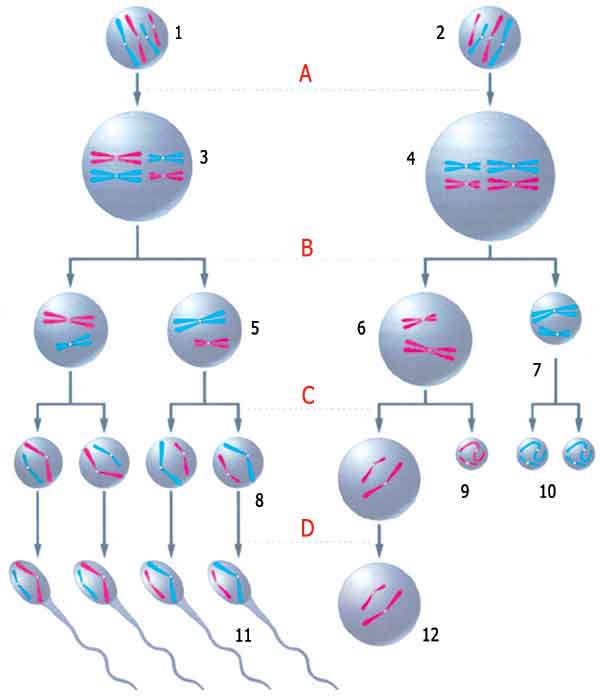 | |
| A. Development/Growth | C. Meiosis 2 |
| 1. Spermatogonium (one of the undifferentiated, immature sperm cells) | |
| The above diagram shows the developmental stages of the mother's egg cell and the father's sperm cells. It also illustrates the transfer of chromosomes, packets of genetic information, carried by the sperm and egg. Chromosomes from the mother and father determine all the characteristics a person will possess in future. Even while a human being is still no more than a fertilized egg cell in the mother's body, all features such as eye color, blood group, facial shape and bone structure are determined. | |
From the moment an egg is first fertilized, all events concerning all the biochemical and physical developments that will give a human form to the growing embryo take place under the control of the blueprint in the DNA. Prof. Phillip E. Johnson refers to the flawless nature of the system:
Instructions in the fertilized egg control embryonic development from the beginning and direct it to a specific outcome. This "full and complete set of instructions" employs the material processes of chemistry and physics but is not created by those processes. Similarly, the software in a computer employs natural processes to generate a word processing document, but the software has to be written by an intelligent agent.99
In addition, the blueprint for a human being also includes the production of its materials, and the biochemical factories in which those materials will be manufactured. It is nearly impossible to compare the human body's blueprint to anything else, because whatever analogy we consider will still fall far short of the complexity in a single cell. Gerald L. Schroeder describes the extraordinary nature of what lies hidden in that complexity:
The beauty and awe of life's genesis lies in the details. Skipping over the intricacies can lead a person to believe that milk just naturally comes in containers, and is not the end result of a process starting with sunlight shining on grass. What follows is just a sampling of the relevant steps in gestation, each revealing only a hint of the complexly ordered wisdom built into the process.100
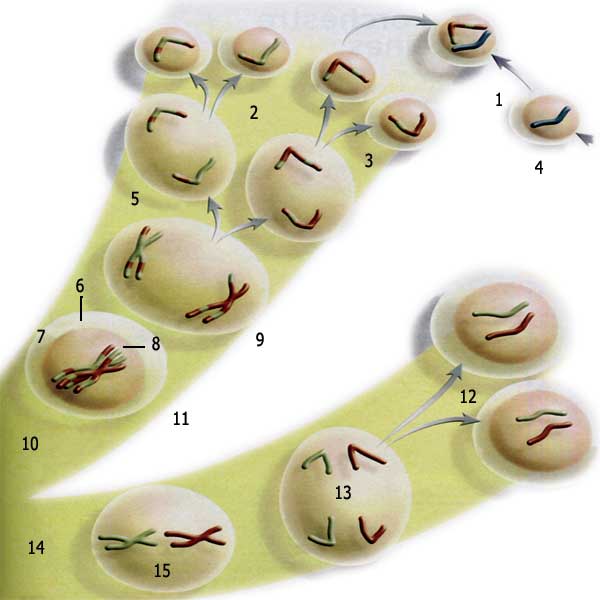 |
| 1. Fertilization by a gamete from the second parent guarantees genetic mixture. |
| The fertilization of an egg by a sperm is the beginning of a new human life. The thousands of genes all have very particular functions. These determine countless details such as the baby's eye and hair color, the shape of its face, its skeletal structure, internal organs, brain, nerves and muscles. |
The inanimate, unconscious atoms that make up the cell cannot make a blueprint, lay out a project, write and decipher a code, take precautions at various stages, establish a system for the preservation of information and to perform many other such feats. Anyone able to think independently of materialist and Darwinist dogmas will appreciate that such an order cannot come into being spontaneously, but that on the contrary, it is the work of our Almighty Lord's sublime intellect. By the will of Allah, elements in the lifeless earth come together to give rise to a living human being, and perform the tasks entrusted to them with flawless co-ordination. In the Qur'an, Allah reveals that:
He Who has created all things in the best possible way. He commenced the creation of man from clay. (Surat as-Sajda, 7)
Genetic Data Combine Together
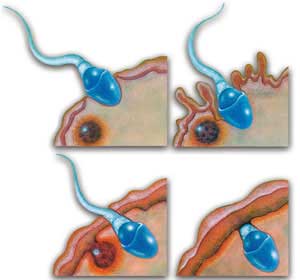 |
| Just one out of millions of sperms succeeds in piercing the protective shell around the egg. In the final stage, the sperm's tail breaks off and is left outside. Thus fertilization has taken place and the construction of an embryo body can now begin. |
The fertilization of an egg by a spermatozon is the beginning of a new human life. When the sperm and egg encounter one another, they are biologically able to recognize one another thanks to the way that the molecules on their surfaces fit exactly into one another. These molecules lock on to one another, and various sperm cells bond to the soft shell of the egg and begin striving to enter.
But only one out of the many sperms is successful. Each one carries its own genetic package, and every sperm cell differs from all the others in many regards. Since the father's sperm carries the genetic message that determines the baby's gender, whichever sperm enters the egg first will be the one that determines the embryo's gender. Fertilization is the term for the moment that the successful sperm is embedded completely in the egg, with its tail and all other parts. Each one of these stages takes place within the destiny set out by Allah, Who reveals this fact in verses:
We created you so why do you not confirm the truth? Have you thought about the sperm that you ejaculate? Is it you who create it, or are We the Creator? (Surat al-Waqi'a, 57-59)
When the sperm fertilizes the egg, the mother and father's genes combine to determine all the features of the as yet unborn child. Each of the thousands of inherited genes has very particular functions, determining the unborn baby's future hair and eye color, the shape of its face, its skeletal structure, and the countless details in its internal organs, brain, nerves and muscles.
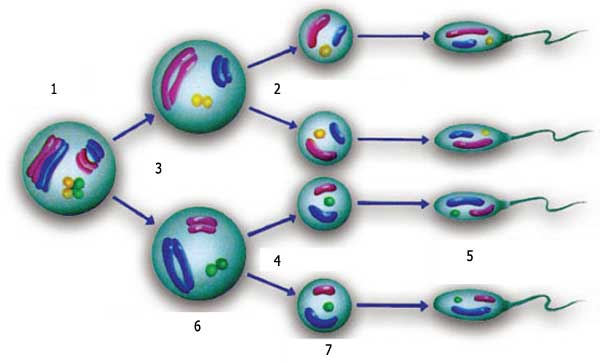 | |
| 1. Spermatogonium (46 chromosomes) | 5. Sperms (each with 23 chromosomes) |
| In males, sperm formation takes place with the division of the main sperm cells (spermatogonium). Reproductive cells act under strict supervision from the very first moment they begin to divide. Each sperm carries future genetic information from the father. Thanks to this organization, the first copy of the DNA molecule forms in a new cell when the sperm and the egg come together. That new DNA will carry the genetic code in every cell until the end of the individual's life. | |
The first copy of the DNA molecule that individuals will bear in every cell until the end of their lives forms inside the initial cell when the sperm and egg join together. The well-known chemist Prof. Wilder Smith emphasizes the perfection exhibited in the egg cell:
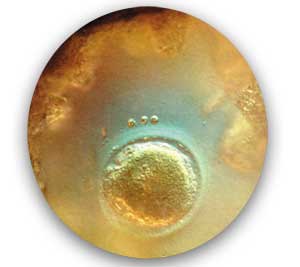 |
| The egg cell is just 150 microns in size. (One micron is one thousandth of a millimeter.) (Left:) The cell that emerges from the combination of the egg and the sperm must divide and multiply millions of times in order to assume a human appearance. |
On paper using our alphabet system, this human genetic information on one human zygote would fill over 1,000 volumes each of 500 pages--a total of 500,000 printed pages. That is, one human egg the size of a pinhead holds 500,000 printed pages' worth of information and chemical instructions. The egg--and the cell in general--is a masterpiece of miniaturized information storage and retrieval.101
With the addition of a sperm cell's genetic information to an egg cell, a total of 1027 atoms assume an extraordinarily organized form.102 In his book , Our Molecular Nature, David S. Goodsell describes the combining of these genetic data:
Parents each provide half of the set of 46 strands, so our cells contain two similar sets of 23 strands. The choice between reading the mother's or the father's version in each particular case provides the rich mixture of inherited traits seen in children. Features that may be traced to a single protein show very specific rules of heredity; if neither parent provides the recipe for tyrosinase, the child will be albino. Other personal features –shape of the nose and eyes, build of body, temperament– may depend on the combined action of many regions of DNA, leading to subtle mixtures of recognizable traits from each parent.103
The astonishing information contained in the DNA of all living things clearly reveals intelligence and the fact of creation. Every new individual will have an utterly unique genetic program. The moment that the combining of the genetic data from the mother and father is complete, the new cell is given the name zygote. That single cell then divides into two others, each identical to the original.
The Cell: Building Blocks of a Human is Being Formed
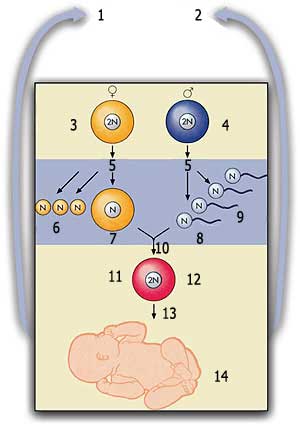 | |
| 1. Female | 8. Sperm |
The structure resulting from an egg and a sperm combining together is given the name zygote and consists of a single cell. The first zygote has to multiply in order to assume human size and shape. The cell begins dividing as if following a computer program, with a high level of intention and purpose. In the zygote, the DNA replicates itself. Once the amount of DNA in the cell has been doubled, the cell immediately begins dividing. One of these doubled DNA strands goes to one cell, while the other is forwarded to the second. Now that the cell has been divided into two, division continues until a baby is fully formed inside the mother's body. This process is repeated so many times that the cells must divide trillions of times before assuming the form of an embryo.
Development of the complete embryo takes place in a coordinated manner by way of the messages that one cell receives from and sends to other cells. The way cells can work in harmony with one another arises from a continuous molecular dialogue among them, in the light of genetic instructions that form within the baby's genetic program from the first day that the germ cells from the parents come together. After this, every time a cell divides and two new cells are formed, an exact copy of all the genes is produced, and this copy is transmitted to every new cell. For that reason, all the cells in your body possess exactly the same genes and contain the whole of the genetic program. 104
Although the cells in your body are in different locations (the kidneys, liver or arm, for example), they carry the same information. But different types of cell use different sections of the same data bank, performing different tasks in the light of those instructions. Just as in computers, the original of the program is not taken outside the main processing center--in this case, the DNA. Instead, new copies of the DNA is produced and are taken to wherever they are required.
Human cells vary greatly in their structure. For instance, in addition to having different shapes, liver cells, muscle cells and nerve cells also produce different proteins and carry out very different biochemical processes. But they all have just one single variety of DNA inherited from the original fertilized egg. Every cell uses different regions of the total information in that DNA. If cells did not use different parts of the identical genetic information and multiplied in the form of just one type of cell type, a human being might develop as a mass of bone or a collection of skin. However, as revealed by Allah, the Compassionate and Merciful, in the verse "We created man in the finest mould"(Surat at-Tin, 4), He has created us as living things with esthetic, symmetrical and superior features.
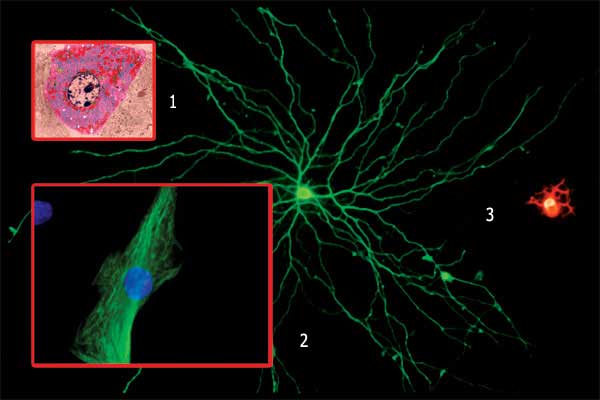 |
| 1- Liver Cell, |
Cell Division Continues
During cell division, every cell possesses all the complex contents described earlier, including mRNA, tRNA, ribosomes, proteins, and enzymes. Some 5,000 of these are produced in one second.105 In the words of Prof. Gerald Schroeder, "The miraculous nature of life is found in its details."106 106By the eighth week, all the embryo's major body parts have been formed, and it turns into a fetus.107
And when the cell needs to divide, the entire tape [DNA] must be split apart, duplicated and repackaged for each daughter cell. No one knows exactly how cells solve this topological nightmare.108
Predetermined solutions exist for all kinds of problems inside the cell, and these have been recorded inside the genetic information contained in the very first cell. Each of these features is evident proof of how human beings are created in a perfect manner. There are even more miracles of creation that could not possibly be covered in this book.
Another of the astonishing features in the cell is that not all the genetic program is constantly active. You might expect all the genetic information to be ready for use. But in that event, every cell would produce only copies of itself, resulting in masses of only one type of cell. The reason why there is such a variety of cells produced, all with different functions, is the genes' property of being switched on and off.
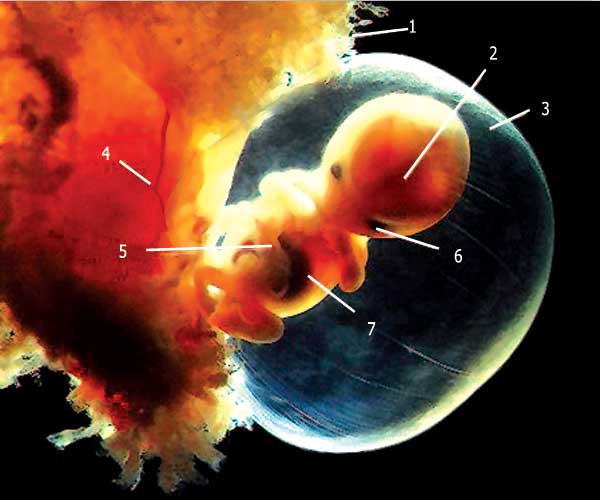 | |
| 1. Chorionic Sac | 5. Umbilical Cord |
| By the eighth week, the embryo, all of whose basic parts have now become apparent, has become a fetus. All this development takes place within the blueprint recorded in the genes. | |
Genes are like sentences written in a chemical language. Each cell opens up only part of the genes in a chromosome and "reads" only that open section. The rest of the genes remain inert.
This turning on and off of genes is known as gene regulation, which occupies a very important place in human development. Different regions of the genes are switched on and off during the course of embryonic growth; thus a brain cell looks different from a liver or muscle cell and performs entirely different functions. As you now know, the type of cell is determined according to the varieties and quantity of proteins it produces. Cells become liver cells, stomach cells, skin or muscle cells because of the proteins they manufacture. And the genes tell the cells which proteins to produce. This production takes place as a result of some genes being switched on and others off. Liver cells, for example, produce different proteins with different properties by switching on different sets of genes than do skin cells.
 |
| Glory be to Him Who created all the pairs: from what the Earth produces and from themselves and from things unknown to them. |
Since the genes tell the cells which proteins to produce, any cell lacking genes could survive for only a short time, because it needs to be given instructions on what proteins to manufacture. Otherwise, the supply of fresh proteins would shortly come to an end, and the cell would be unable to perform vital functions. At certain times, for example, the genes instruct the cells to manufacture the special proteins that permit blood to clot. Flawed genes, however, cannot manage this, resulting in hemophilia, a disorder of the blood-clotting mechanism.
İThe human body needs to manufacture some proteins throughout its entire life, and others solely at times of need. For that reason, genes regulate every cell so that it produces the correct amount of protein at the exact times required. In the developing embryo, for example, several proteins are necessary in a very short space of time. The proteins produced by any specific cell depend on where in the embryo it lies, are, the developmental age of the embryo, and the instructions it receives from its own genes and from other cells. But scientists cannot say how the cell knows when to ignore which part of the enormous blueprint it possesses, and when. How are the genetic "files" for every feature and organ opened or closed at exactly the right time? Who issues the instructions to suppressor genes and to other genes that halt that suppression? These are questions that scientists have yet to answer.
The scientific literature refers to this ability as regulation. To claim that this process originated in a chance manner is incompatible with scientific logic. Here we are confronted by the same glorious and rational plan, which belongs to the One and Only Allah, the Lord of the Worlds, to Whom the entire blueprint and this extraordinary system belong.
A miniature human being starts to form as a result of cells establishing communications with one another, grouping together and working as a team. It takes three weeks more for the embryo to develop its complete anatomy. On day 24, the embryo's arms still cannot be detected, although by day 26 they are visible as small buds on either side of the body. The upper and lower sections of the arms then develop in just 48 hours. A few days later, the legs begin to appear. The legs elongate over the following months, and eventually the fingers and toes emerge from them.109
| The development of organs and organ systems in the embryo | |
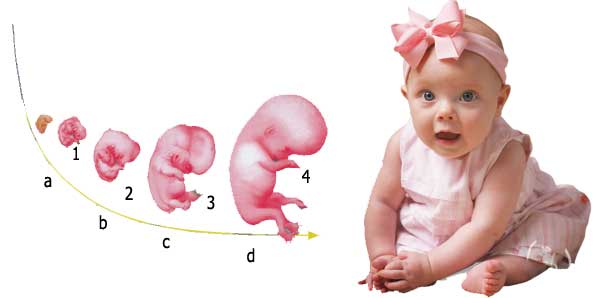 | |
| 1- Neck bending, | a. 5th week |
| Cells differentiate the more they divide, assuming new duties and heading to wherever they need to be in the body. Instead of forming a mass of flesh all consisting of exactly the same cells, eye cells develop just where they need to be. Others inside the rib cage will constitute the heart, and skin cells, for example, cover the entire body. | |
All these stages, which we can only sit back and observe, are all parts of the construction plan in DNA. Everything takes place in a highly controlled manner, with not the slightest confusion arising. It is of course irrational to speak of "coincidences" in reference to such flawless order. Moreover, even Darwinist scientists who suggest that living things are shaped as the result of chance factors refer to a surprising order in the series of precautions that have been taken by the cells: intelligent behavior, economical and efficient systems, and co-operation and harmony in the formation of a human embryo. The contradiction here is clear; there can be only chaos, irregularity and discord anywhere chance prevails.
The Miracle in Cell Differentiation
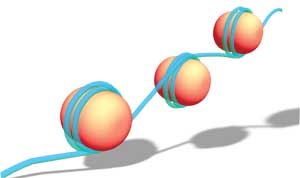 |
| histone |
The way cells produce a variety of different proteins and develop different organs in a programmed manner, is referred to in medical language as differentiation or morphogenesis. Cells become differentiated as they divide, assuming different tasks and going to those regions in the body where they are needed. It is not a mere collection of tissue that grows from identical cells. Some cells go where they must in order to become eye cells, some enter the chest cavity and make up the heart, and others cover the entire body in the form of skin. All cells multiply to an extent required by the particular tissue they are to comprise, and begin forming organs by combining with one another to construct the requisite structures.
During all these events, the cells function just like construction teams working closely together in a process calling for the greatest care and attention. Each "member" cell has a complete knowledge of the blueprint, letting them all work with communication and intense cooperation. How does such advanced order come about? How do cells know where to go, which organ they will develop and what to do at their destinations? At the same time, how do they manage to work in such harmony with other cells? The Israeli biophysicist Dr. Lee Spetner asks about the miraculous creation involved here:
How does the development program work, and how is it so perfect? As we have seen, development starts with one cell, which divides into two. The two divide into four, and so on. At some point, the cells differentiate, which means they change their character. Eventually, some of the cells become one kind of tissue or organ, while other cells become other kinds. And it happens the same way nearly every time. How does it happen? 110
The answer to these questions is evident: Living things have been created in a flawless manner, and the artistry and knowledge in that creation is that of Almighty Allah, the Lord of All. In one verse, we are told that:
He created the heavens and the Earth with truth and formed you, giving you the best of forms. And He is your final destination. (Surat at-Taghabun, 3)
On the other hand, different varieties of proteins are also produced for various cells. As an embryo develops inside the mother's body, the DNA in the cells that will constitute its eyes produces only proteins concerned with vision. In the same way, the DNA in the cells forming the embryo's brain produce only proteins concerned with the neurological functions.
The important point is that information to make up all of a human being's organs are contained in the DNA of cells in every part of the body, whether they be liver or kidney cells, or any other kind of cell. However, only the proteins to be produced for the organ in question actually emerge from all that genetic information. In other words, every cell contains information about the proteins of every organ in the human body, but does not manufacture them all. Only proteins concerning the organ to be formed are produced. In order for this to happen, the surface of the DNA is coated with a special protein known as histone that prevents the production of proteins that have nothing to do with that particular organ. One of the greatest secrets that baffle scientists is how the histones in the cells know which genes to suppress and which to leave activated, because proteins are simply molecules made up of inanimate atoms. Obviously, atoms devoid of consciousness and intelligence cannot give rise to such a magnificent marvel of creation.
The coordination in the cells during differentiation and construction is ensured by the DNA molecule. Yet DNA is not a chemist equipped with the latest technology, nor a super-computer capable of performing trillions of processes a second. DNA is a molecule consisting of atoms like carbon, phosphorus, nitrogen, hydrogen and oxygen.
The trillions of cells in the human body emerge from one another by way of division, yet different genes in every cell go into action at different times, and so cell differentiation becomes possible. Every cell resulting from the division and multiplication of the original cell contains all the genetic information with which to produce heart muscle, skin, blood cells and every other bodily tissue. Yet although every cell's DNA possesses a full description of the body, only certain genes are active at different phases of development and in different organs. For example, the codes for the kidneys' formation and function are present inside every cell; but only relevant genes become active in this organ, at specific times, during development. Similarly, specific enzymes such as glucose 6-phosphate are basically present in the liver, yet although all the cells of other organs possess the description of that same protein, they never actually manufacture it. A cell in the eye, for instance, does not produce this enzyme; it manufactures only those that are necessary for vision. Nerve cells specialize in carrying messages and instructions between the brain and the organs. Liver cells specialize in neutralizing toxins, while fat cells specialize in storing food for times of scarcity. They never commit any errors such as producing digestive enzymes concerned with the stomach. So who establishes this flawless division of labor? Who gives the order for cells to divide and subsequently specialize in such different tasks? Furthermore, how can all the body's cells possess an awareness, an obedience, and work in such a perfectly disciplined and organized way? Obviously, none of these actions came about by chance or are purely haphazard systems. They all take place by the leave of Almighty Allah, Who "directs the whole affair from heaven to Earth"(Surat as-Sajda, 5)
This perfection is not restricted to cells being in the right place at the right times and activating the proper genes. Cells must also be present at the right stage of life and in the correct quantities. In just about all cells, some maintenance genes work all the time. Other genes function in some cells for just a few hours, after which they are placed on standby, ready to function again in the future. Milk production, for example, is accelerated by genes during suckling. The existing genetic information is acted upon at the appropriate time and place, at the appropriate level. Such consciously planned, deliberately calculated and rational use of the billions of pieces of information contained within DNA can definitely not be explained by way of any evolutionist claims of chance. To stubbornly regard chance as the cause of such extraordinarily planned and organized events, taking place in such a microscopically small space, is a completely contrary to logic. Even evolutionists admit that they are far from being able to account for this differentiation and immaculate division of labor in cells. The Turkish evolutionist and microbiologist Prof. Ali Demirsoy makes this admission:
In essence, the way that several cell groups with very different structures and functions comes into being from a fertilized egg has still not been satisfactorily explained. 111
A National Geographic Society book, The Incredible Machine, refers to scientists' inability to account for human creation:
Its 100 nonspecialized cells must somehow multiply into trillions of cells that make up the most complex vertebrate on Earth--the human being. The phenomenon of differentiation--how cells assume their different forms--remains one of the most baffling questions of science. How are DNA's orders issued to the cells? Is the story of life written once, in the fertilized egg? Are its orders parceled out to offspring cells as it divides?. . . Now there are new mysteries. Today we know that all cells are derived from generalized cells, and each one contains the genetic code for the whole body. But how does a cell, supplied with the voluminous script for all of life, come to play its exact role in the development of a human? How does a cell that could turn into anything turn into something? How is a rod cell in the retina, for example, designated to obey only orders to manufacture a light-absorbing protein? How does a pancreas cell know to produce insulin?112
Dr. Lee Spetner refers to the emergence of a thinking human being from a single cell:
The perfection of the eyes, the limbs, even the finger nails and the eyelashes. How did this perfect and complex organism develop from a single cell? What kind of program orchestrates this development? Eyes that see, ears that hear, a brain that can think and command the movement of complex organs, have all developed from a single cell? That each of us started as a single cell and developed into a functioning, thinking, human being is mind-boggling.113
Clearly, none of these extraordinary phenomena could be the work of chance or of the cells themselves. That being so, to whom does this intelligence belong, this power that directs all these events in the cell, creates them in line with a specific purpose, and compresses billions of pieces of information into a space too small to be seen with the naked eye? The only answer to that question is that our Almighty Lord has created, with His infinite mercy, human beings with their present orderly forms, and has bestowed their bodies' organization and the order of the surroundings as a blessing. It is revealed in one verse that:
He has given you everything you have asked Him for. If you tried to number Allah's blessings, you could never count them. Man is indeed wrongdoing, ungrateful. (Surah Ibrahim, 34)
How Genes Control Cell Division and Growth
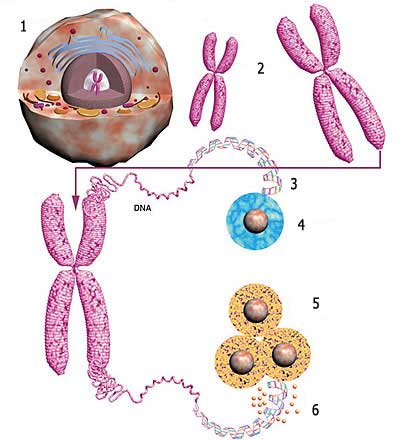 | |
| 1. Cell | 4. Cell ceasing copying |
One of the genes' most important tasks is controlling how embryos develop. Intensive adjustments during this process mean that the dividing cell's DNA is copied accurately, that any errors in the DNA are rectified and that every new-formed cell receives a full complement of chromosomes. In this process, some genes have various control points that ensure that errors are checked and that if anything goes wrong, the process is halted for repairs to be made. If an irreparable error arises in a new cell's DNA, the pre-programmed cell death known as apoptosis takes place. By this widespread method, the body gets rid of cells it has no use for. The cells that self-destruct by apoptosis break apart and are recycled by a kind of white blood cells known as macrophages. Apoptosis helps protect the body against genetically impaired cells that might lead to cancer, which can arise when normal cell division is impaired. Division then takes place in an uncontrolled and irregular manner, and genetic impairments accumulate, leading to a cancerous tumor. Apoptosis also plays a very important role in embryonic development and the protection of adult tissues.
One of the most important discoveries made in molecular biology is that some genes have more influence than others. They are organized according to their degrees of empowerment. For example, some genes are responsible only for fixed tasks such as making hemoglobin, hair growth or producing digestion enzymes. These molecular workers have regulator genes, which operate and halt them. During fetal development, for example, they stop the hemoglobin gene from working setting it back in motion when necessary. Regulator genes act like supervisors of both the "worker" and "middle-management" genes. Their decisions affect dozens or even hundreds of lower units; and so vitally important is their work that if they are damaged during the embryonic stage, death in the womb can result.
Reflect that genes are mere molecules, made up of atoms. So how have these molecules established such an organization among themselves? How is it that a molecule decides to stop a human being from growing any taller and transmits this decision to others? How do they understand that decision and act on it? Who installed this discipline? Furthermore, trillions of genes have been performing these disciplined tasks with the same, obedience, intelligence and consciousness for millions of years. It is nonsensical to maintain that any such system came about by chance. No doubt it is Allah, Lord of All, Who programs genes in the most rational and flawless manner.
Say: "Who is the Lord of the heavens and the Earth?" Say: "Allah." Say: "So why have you taken protectors apart from Him who possess no power to help or harm themselves?" Say: "Are the blind and seeing equal? Or are darkness and light the same? Or have they assigned partners to Allah (Who create as He creates, so that all creating seems the same to them?" Say: "Allah is the Creator of everything. He is the One, the All-Conquering." (Surat ar-Ra'd, 16)
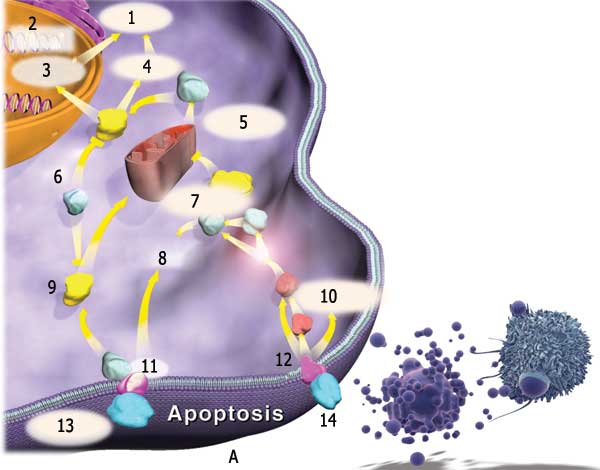 | |
| 1. Cell Death | 8. Phosphorylation |
| If an irreparable error occurs in a cell's DNA, then the programmed cell death known as apoptosis may take place. This rids the body of unnecessary cells. Apoptosis protects the body from genetically impaired cells that might lead to cancer. This system is the way that Allah, the infinitely Compassionate and Merciful, protects us. | |
The Wisdom Behind Mitosis and Meiosis Division
Cell division takes place in two fundamental ways, and each occurs at just the right time and in just the right way. The first of these, meiosis, takes place during fertilization and is a form of division of the cells constituting the egg and sperm.
It is thanks to this division that human beings have the same number of chromosomes in very generation. The so-called germ cells in the ovaries and testes reduce the number of chromosomes from 46 to 23 in order to form the egg and sperm cells, respectively. When the sperm and egg combine during fertilization, the 46 chromosomes are thus completed in the embryo. But is it possible for cells themselves to make this flawless mathematical calculation? They possess such foresight and know what they must do to form a complete chromosome when they are combined. It is Allah Almighty, Who causes them to act in this way and Who establishes this immaculate system. It is revealed in one verse of the Qur'an that:
... Allah always achieves His aim. Allah has appointed a measure for all things. (Surat at-Talaq, 3)
There is great wisdom behind our Lord's involving meiosis in the emergence of a human being. For instance, the new embryo took all its chromosomes from only the mother or only the father, every zygote would still have 46 chromosomes, just like a normal human being. But there would be no human diversity on Earth. Every newborn baby would be an exact cloned copy of its mother or father. From that point of view there is enormous wisdom behind meiosis, which has been operating in a regular, flawless manner since human beings were first created. Genetic diversity is made possible by the process of DNA shuffling during germ cell division. There are so many possible combinations of DNA that the odds of two different fertilizations from the same two parents bringing two completely identical children into the world are infinitely small--approximately one in 70 trillion. 114
| Meiosis Division |
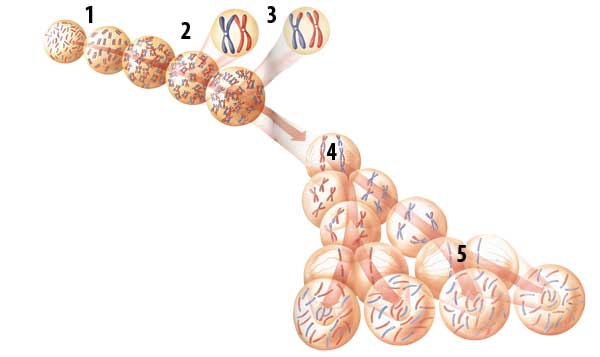 |
| 1- Chromosomes from the mother and father group together in pairs of 23 each. |
| Meiosis is a form of cell division constituting the egg and sperm cells. Thus every newborn human being is a new individual with a unique mixture of the mother and father's genes. |
Prof. Gerald L. Schroeder also notes the extraordinary nature of the emergence of a human being with no abnormalities and a highly regular and attractive appearance, during the combination of genetic data:
In excess of five million combinations are possible in the complete set of traits housed within the human genome. In addition to this multiplicity, while the pairs are aligned at the equator of the cell, prior to their being pulled to opposite sides, they swap gene pieces in a process termed crossing over. Each of the two new chromosome sets now contains pieces from the mother and from the father. . . by this stage, the number of possible combinations runs into the multiples of trillions. With this vast potential for variety, it is not surprising that no two humans are identical. With all this genetic promiscuity, it's amazing that the vast majority of births produce normal-looking kids.115
| Mitosis Division | |
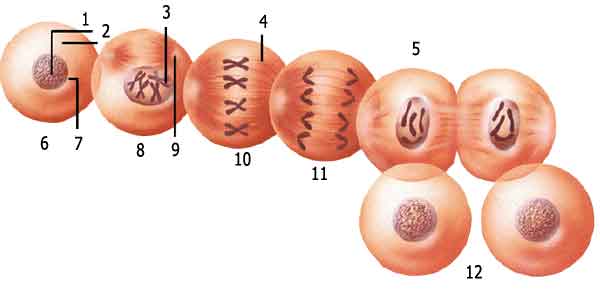 | |
| 1. Chromatin | 7. Nucleus |
| In the cell division known as mitosis, the cell copies all its contents,including the chromosomes and divides into two twin cells. This makes possible the building of new tissues. | |
We have already mentioned the dangerous consequences of errors in the DNA helix. Bearing in mind, too, that very small rearrangements in genes can also have highly negative results, the way that flawless human beings emerge from a combination of such data banks is one of the proofs of Allah's infinite might. In one verse, our Almighty Lord states that:
He is Allah–the Creator, the Maker, the Giver of Form. To Him belong the Most Beautiful Names. Everything in the heavens and Earth glorifies Him. He is the Almighty, the All-Wise. (Surat al-Hashr, 24)
The second form of cell division is mitosis, during which, the cell copies all the information contained within it, including the chromosomes, and divides into two twin cells. This progeny makes it possible for new tissues to be constructed. Thousands of heart cells are needed for the formation of the heart, for example. Stomach or kidney cells cannot replace them, so it is essential for the heart cells to multiply in order to give rise to a functioning heart. Similarly, when you cut your finger, new skin cells at the site multiply to heal the cut. In the same way, mitosis makes a baby grow during infancy and childhood. By multiplying in an ordered manner, bone cells build first the child's skeleton and then the adult one.
So important is this process that various genes carefully control the stages of mitosis. The perfection here is very striking. Two flawless cells emerge from one other cell, fully equipped to produce new cells just like themselves.
In addition, it is also most amazing that mitosis division should begin immediately after fertilization. In order for a new baby to form, cells begin dividing with an extraordinary capacity. They shape its organs, establish connections between them, and over the course of nine months, assume the appearance of a normal human being. The sublime consciousness manifested here, and each of the stages that takes place in the light of a specific aim, take place at Allah's command and under His inspiration. In the Qur'an, our Lord tells us that:
Has man ever known a point of time when he was not something worth mentioning? We created man from a mingled drop to test him, and We made him hearing and seeing. We guided him on the Way, whether he is thankful or unthankful. (Surat al-Insan, 1-3)
Say: "It is He Who brought you into being and gave you hearing, sight and hearts. What little thanks you show!" (Surat al-Mulk, 23)
Genetic Diseases Reveal That in DNA, There is No Room for Chance
The importance of the perfection and order inside the DNA molecule is revealed by genetic diseases. A single molecule's error could damage, or even kill, the human being concerned. But these molecules clearly behave at the command of a superior intellect and almost never make any errors in the work they do. The 100 trillion DNA molecules in your body, the nucleotides that constitute that DNA, the proteins that build the cell, the enzymes that so perfectly organize the traffic among those cells, the amino acids that make up the enzymes, and the 100 trillion cells that contain that DNA and make you, all are structures with a sublime organization and order.
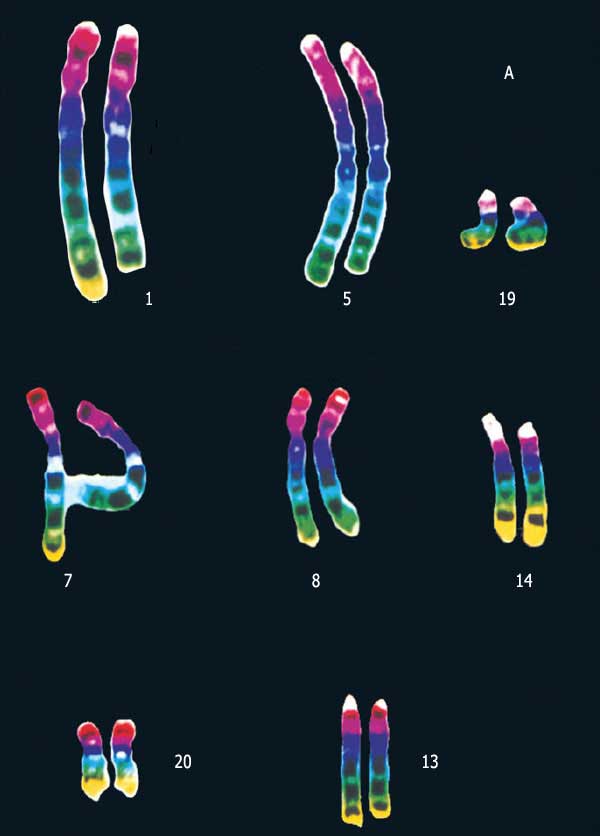 |
| Chromosome 1: Chromosome 5: Chromosome 19: Chromosome 7: Chromosome 8: Chromosome 14: Chromosome 20: Chromosome 13: |
| Alongside the relevant chromosomes are listed some of the diseases -mutations, in other words- that emerge as a result of impairments in these chromosomes. All these genetic diseases show the delicate balance and order in DNA, as well as revealing the impossibility of living things having developed by way of mutations. |
Bear in mind the delicate order and balance in the information contained in DNA, and you can better see how impossible the idea of chance emergence truly is. As we have already shown in some detail, DNA's information is made up by the "letters" A, T, G and C laid out one after the other in a particular and meaningful way. In this sequence, however, there must not be a single mistake. In a whole encyclopedia, a spelling error or wrong letter may not be that important and may usually not even be noted. In contrast, a single error in any step in DNA –say, the faulty coding of letter number 1 billion, 719 million, 348 thousand and 632– could have lethal consequences for the cell, and therefore for the entire human being.
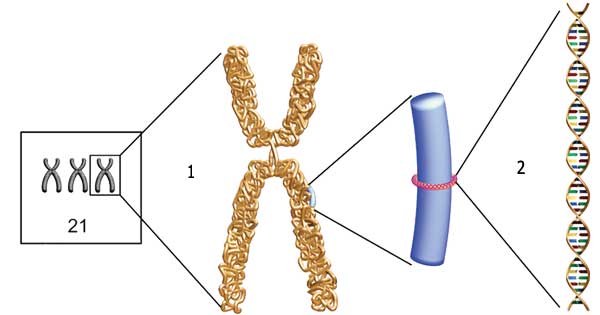 |
| 1- Extra 21st chromosome, |
| Our cells have 23 pairs of chromosomes. If these pairs possess more chromosomes for any reason, their equilibrium will be impaired. In Down syndrome, the sufferer has a total of 47 chromosomes instead of 46. Three chromosomes can be seen in the 21st chromosome in the chromosome map. |
The minimum change in a genome creates a change in a nucleotide. Yet even here, a seemingly insignificant error can give rise to very serious consequences. The presence of A (adenine) instead of C (cytosine) in the pigment-coding gene known as rhodopsin in the human retina causes a disease leading to blindness.116
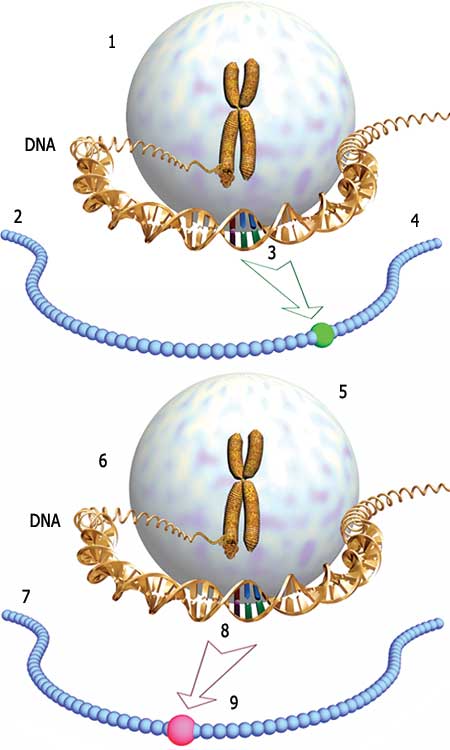 |
| 1. The substance known as aflatoxin, produced by a microscopic fungus, causes mutation in the P53 gene. |
Inherited diseases that are almost impossible to treat can emerge as the result of an impairment arising in a single gene. Children born with the disease phenylketonuria, for instance, are unable to metabolize the amino acid phenylalanine, found in protein foods. As a result, the increasing phenylalanine and its waste products in the blood and other body fluids damages the growing child's brain, leading to serious mental impairment and various diseases of the nervous system. This disease is caused by a defective gene responsible for the manufacture of the enzyme hydroxylase. Gene defects of this kind are the causes of other diseases such as Mediterranean anemia, hemophilia, cystic fibrosis, familial Mediterranean fever (FMF) and congenital deafness.
Many other inherited diseases that give rise to very serious consequences are caused by various defects in genetic structure. The main reason for every one of these disorders is just a few of the billions of letters in the genetic code being in the wrong place.
In the genetic disease known as Huntington's disease, patients appear healthy up until the age of 35. After that age, however, uncontrollable contractions suddenly take place in the arms, leg and face muscles. Since this fatal and incurable disease also affects the brain, the sufferer's memory and mental functions grow increasingly weaker. All these diseases demonstrate that the genetic code has been balanced so flawlessly that the slightest alteration in the system can cause serious problems. Just one letter too few or too many can give rise to fatal diseases or serious handicaps that last throughout the sufferer's life. Therefore, it's impossible to claim that such a delicate order and regularity came about by chance and--as maintained by the theory of evolution--developed spontaneously through mutations.
That being so, how did the magnificent information contained in DNA come about? How was it coded? Evolutionists, who trace the origins of life to chance, have no answer to give. Those who claim that billions of pieces of data, were written by chance will of course have no answer to give. In the same way that a book has an author, so the information in DNA has a creator; and that Creator is our Lord, Almighty and Omniscient Allah.
Random effects only damage living things, because of the way the genetic code is encoded. Just about all known genes contain more than one piece of information about the organism. The molecular biologist Michael Denton describes this property of genes:
The effects of genes on development are often surprisingly diverse. In the house mouse, nearly every coat-colour gene has some effect on body size. Out of seventeen x-ray induced eye colour mutations in the fruit fly Drosophila melanogaster, fourteen affected the shape of the sex organs of the female, a characteristic that one would have thought was quite unrelated to eye colour. Almost every gene that has been studied in higher organisms has been found to effect more than one organ system. . . .117
Because of this feature in the genetic structure, any random change in any gene in the DNA will impact on more than one specific organ. The impairment will have wide-ranging destructive effects.
In short, health cannot emerge by chance. On the contrary, it is a blessing from our Lord, the Compassionate and Merciful, the result of a sublime creation. Allah shows us, with examples, that He can take back this blessing whenever He so chooses and can create a lethal disease in an unknown part of the body.
There is, of course, great wisdom behind these deficiencies. People need to give thanks to Allah, Who bestows their health upon them and "formed them as a man" (Surat al-Kahf, 37). When they fall ill, they must be aware that both health and sickness derive from Him and beg for help, as did the Prophet Abraham (pbuh). As he put it, "and when I am ill, it is He Who heals me."(Surat ash-Shu'ara, 80)
Footnotes
99. Phillip E. Johnson, The Wedge of Truth: Splitting the Foundations of Naturalism, InterVarsity Press, USA, p. 134.
100. Gerald L. Schroeder, The Hidden Face of God, pp. 79-80.
101. A. E. Wilder-Smith, The Natural Sciences: Know Nothing of Evolution, T. W. F. T. Publishers, ABD, p. 82.
102. Gerald L. Schroeder, The Hidden Face of God, p. 49.
103. David S. Goodsell, Our Molecular Nature, p. 37.
104. Geraldine Lux Flanagan, Beginning Life, Dorling Kindersley, London, 1996, p. 42.
105. Gerald L. Schroeder, The Hidden Face of God, p. 112.
106. Ibid.
107. Ibid.
108. Nicholas Wade, "How Cells Unwind Tangled Skein of Life", The New York Times, October 21, 1997, Tuesday, s. F1.
109. Geraldine Lux Flanagan, Beginning Life, p. 43.
110. Lee M. Spetner, Not By Chance, Shattering The Modern Theory of Evolution, p. 234.
111. Ali Demirsoy, Kalıtım ve Evrim (Heritage and Evolution), Meteksan Publishing, Ankara, 1984, p.158.
112. The Incredible Machine, National Geographic Society, s. 29.
113. Lee M. Spetner, Not By Chance, Shattering The Modern Theory of Evolution, The Judaica Press Inc., 1997, ss. 233-234.
114. The Incredible Machine, National Geographic Society, p. 29.
115. Gerald L. Schroeder, The Hidden Face of God, p. 72.
116. Lee M. Spetner, Not By Chance, Shattering The Modern Theory of Evolution, p. 45.
117. Michael Denton, Evolution: A Theory in Crisis, Adler&Adler, Publishers, Inc. ABD, 1986 p. 149.
- From the Depths of the Universe to the DNA Molecule
- The Most Advanced Data Bank Known: DNA
- Aspect of The Cell Discovered In the 20th Century
- The Source of the Data of Life
- The DNA Molecule's Miraculous Structure
- DNA's Extraordinary Data-Storage Capacity
- The Cryptography in the DNA Molecule
- Protein Synthesis: The Matchless Production System Recorded in DNA
- The World's Most Advanced Copying Technology
- The Building Plan Recorded in Human DNA
- Darwinist-Materialist Errors Regarding the Human Genome Project
- The Information in Living Structures and The End of Materialism
- Some of Darwinism's Errors on the Subject of DNA
- How the Miracle of DNA Invalidates the Theory of Evolution
- DNA is an Example of Our Almighty Lord's Creative Artistry
